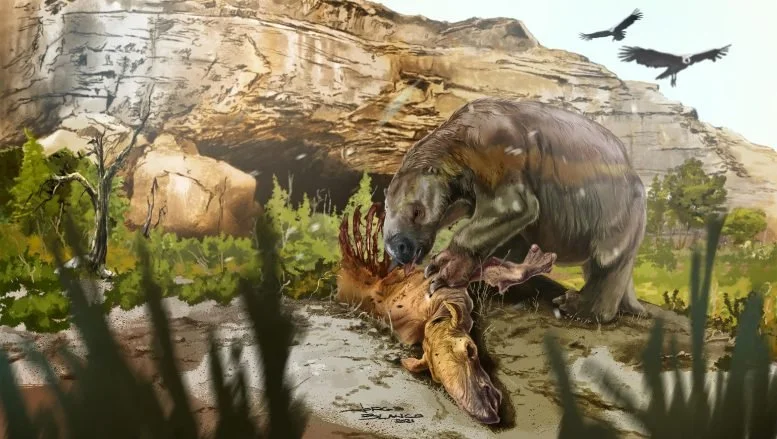
The Rise and Fall of the Giant Sloths
What 35 million years of evolution reveal about resilience, extinction, and the role of humans.
Human-Caused Wildfires Spell Doom for Giant Sloths in California
In a recently published investigation called “Pre–Younger Dryas megafaunal extirpation at Rancho La Brea linked to fire-driven state shift,” Frank O’Keefe from Marshall University and his research team unfold the factors behind the disappearance of enormous prehistoric creatures in Southern California.
First Fossils of an Aquatic Sloth Found in Continental Environment in Argentina
Researchers have discovered the remains of a specimen of Thalassocnus, a marine sloth found for the first time in a continental environment in Northern Argentina. This discovery significantly expands the geographic distribution of this lineage of fossil sloths.
Resurrecting giant ground sloths with Augmented Reality
For a chance to picture what the prehistoric Shasta ground sloth may have looked like, virtual and augmented reality may be our best bet. Ice Age giants such as mammoths, mastodons, giant beavers, saber-toothed cats, and dire wolves once roamed the American continent with giant ground sloths. But around 10,000 years ago, after the end of the last Ice Age, America’s impressive megafauna went extinct.
Prehistoric Rock Art Might be Early Representations of Giant Ground Sloths
In the Amazon rainforests in the country of Colombia, there is a place called Serranía La Lindosa, with rock cliffs decorated in ancient drawings. There are thousands of paintings covering 12 kilometers (8 miles) of rock in an area that has been largely inaccessible.
Mylodon Giant Sloth, opportunistic omnivore?
Sloths these days are small, tree-dwelling animals that live high up in the rainforest canopy and do a good imitation of the plants they eat. They’re slow, they’re green, and they can’t jump—but a new study published in the journal Scientific Reports suggests their ancestors weren’t the strict vegetarians their reputation would have us believe.
Did humans cause the extinction of the giant ground sloths?
“We believe that human beings are mainly responsible for the extinction of megafauna in South America,” said Luciano Prates and Ivan Perez, CONICET researchers at the Faculty of Natural Sciences and Museum of the National University of La Plata, Argentina, and authors of a scientific study on the matter, which is published in the journal Nature communications.
The hidden "armor" found in the skin of a giant ground sloth
Argentinian scientists used X-rays on a 13,000-year-old sloth skin and discovered thousands of tiny bones on the inside.
Being a giant sloth in an ancient wetland
Thirteen million years ago, when giant ground sloths roamed the Earth, a vast wetland known as the Pebas Mega-Wetland System extended across northernwestern South America.
The 'mummified' skin of a giant sloth proves that they coexisted with the first humans of South America
Although it was on display for a long time at the Museum of La Plata, Argentina, its age was uncertain. A new study indicates that giant ground sloths lived 13,000 years ago and coexisted with the first humans of South America.
Love avocados? Thank the Giant ground sloths!
Did you know that we can thank giant ground sloths for the avocados we have today? Giant ground sloths were one of the few ancient herbivores large enough to swallow avocados whole, thus serving as an important seed disperser for these delicious fruits that we know and love today!
Five-ton giant sloth lived in Costa Rica seven million years ago!
A giant sloth weighing five tons and whose height could exceed twice that of a human being was part of prehistoric Costa Rica seven million years ago.













